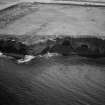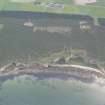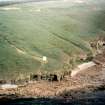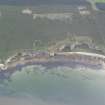Covesea
Cave(S) (Period Unassigned), Human Remains (Period Unassigned), Stake Hole(S) (Period Unassigned), Animal Remains (Period Unassigned), Blade (Flint)(Prehistoric), Crucible (Period Unassigned), Leaf Arrowhead (Flint)(Neolithic), Organic Material (Wood)(Neolithic), Slag (Period Unassigned), Unidentified Pottery(S) (Bronze Age)
Site Name Covesea
Classification Cave(S) (Period Unassigned), Human Remains (Period Unassigned), Stake Hole(S) (Period Unassigned), Animal Remains (Period Unassigned), Blade (Flint)(Prehistoric), Crucible (Period Unassigned), Leaf Arrowhead (Flint)(Neolithic), Organic Material (Wood)(Neolithic), Slag (Period Unassigned), Unidentified Pottery(S) (Bronze Age)
Canmore ID 16280
Site Number NJ17SE 3
NGR NJ 1742 7062
NGR Description NJ 1742 7062 and NJ 1745 7066
Datum OSGB36 - NGR
Permalink http://canmore.org.uk/site/16280
- Council Moray
- Parish Duffus
- Former Region Grampian
- Former District Moray
- Former County Morayshire
NJ17SE 3 1742 7062 and 1745 7066.
NJ 174 707. Two caves with habitation layers of periods from Bronze Age to post-Roman, lie 'about 1000m to the W of the Sculptor's Cave' (NJ17SE 1). (The grid reference falls not 1000m west but about 100m west of the Sculptor's Cave, in the vicinity of the caves published at NJ 1742 7062 and NJ 1745 7066)
I Keillar 1969.
The caves referred to are those published on OS 6" at NJ 1742 7062 and NJ 1745 7066; no further information.
Visited by OS (RL) 28 January 1972.
Laser Scanning (May 2014)
NJ 1742 7062 Laser scanning of the cave was undertaken (as part of the Covesea Caves Project) by Bradford Visualisation (University of Bradford) over two weeks in May 2014. Acoustic modelling and recordings of a lyre and horn instrument were also made by Dr Rupert Till from the University of
Huddersfield.
Although a 25 x 2m trench was laid out, in order to ascertain whether anthropogenic deposits survived within the cave (see entry for Occupation Cave 2), difficulties of access meant that excavation did not take place on this occasion.
Archive and report: RCAHMS (intended)
Funder: Aberdeenshire County Council
Lindsey Büster and Ian Armit – University of Bradford
(Source: DES)
Excavation (May 2014)
NJ 1745 7066 An excavation was undertaken (as part of the Covesea Caves Project) over two weeks in May 2014, to ascertain whether the cave contained any anthropogenic deposits. This was based on an assemblage of material, including human remains, gifted to Elgin Museum by Mr Charles Darge in the late 1960s which purportedly included material from this cave.
Three trenches were opened, two to the rear of the cave (Trenches 1 and 2) and one towards the front (Trench 3). Trench 3 (9 x 4m) was situated over a surface hearth and several alignments of stone and contained several deposits of sterile sand. A sub-surface hearth, located roughly 0.25m below the first, yielded a newspaper cutting dated 1990, and
attested to the high rate of erosion and deposition of sand at the front of the cave.
Trench 1 (4 x 4.6m) was situated over an eroded and partially backfilled excavation trench, which is assumed to have been dug by Mr Darge. The backfill was removed (to reveal a small and deeper trench sitting inside the first) and the main E-facing section was cleaned back for recording. The existing trench was squared off by excavating stratigraphically any remaining in situ deposits. All material was sieved. The trench produced 46 fragments of human bone and a bone pin.
Trench 2 (4 x 4m) was situated opposite (ie west of) Trench 1, with a 0.5m baulk left between them. This area appeared to have not been as badly disturbed by previous excavation. It yielded 73 fragments of human bone (32 of which derived from a thick layer of limpet shells), and artefacts including a Late Bronze Age disc-headed pin, a bone needle, a crucible
fragment and a sherd of later prehistoric pottery.
The cave was laser-scanned by Bradford Visualisation (University of Bradford) prior to excavation. Acoustic recording was undertaken by Dr Rupert Till from the University of Huddersfield.
Archive and report: RCAHMS (intended)
Funder: Aberdeenshire County Council
Lindsey Büster and Ian Armit – University of Bradford
(Source: DES)
Excavation (September 2015)
NJ 1739 7058 An excavation was undertaken (as part of the Covesea Caves Project) over two weeks in September 2015, following a successful field season in May 2014 (DES 2014, 135). Excavation was undertaken in order to a) investigate a larger area of the in situ deposits within the cave in order to identify and characterise the nature and extent of anthropogenic activity; and b) increase the sample of human remains recovered to better understand the character, range and mode of Late Bronze Age mortuary activity revealed in 2014.
Trenches 1 and 2 (first opened in 2014) were reopened (Trench 1 representing the partially backfilled trench apparently dug by a Mr G L Darge in the late 1960s (DES 2014, 134-5) and a further trench (Trench 4, measuring c2 x 7m) laid out between Trench 3 (opened in 2014 but not reopened in 2015) and Trench 1.
In situ deposits in Trench 1 (4m by 4.6m), were preserved below a decayed sandstone layer exposed in 2014. In 2015, this sandstone layer, and associated deposits, were excavated and found to contain human and animal bone, worked flint, and fragments of preserved wood. An AMS date on one
fragment indicates a Neolithic date for the wood. Finds from Trench 1 included a flint blade, a sherd of Early Bronze Age incised pottery, and human bones.
In Trench 2, a complex deposit (visible in Darge’s Trench 1 section) comprising compact sand, fire-cracked stone and preserved turves, yielded metalworking evidence in the form of crucible fragments, pieces of slag, a plano-convex furnace bottom and several fragments of iron. Below this material
was a darker, ashier deposit which contained a dense concentration of human bone. AMS dates obtained in 2015 indicate that these human remains are Late Bronze Age in date (DES 2014, 135).
Trench 4 (2 x 7m) was opened in order to assess the extent of the in situ deposits excavated in the N of Trench 1 in 2014, and to establish the relationship between these deposits and the rockfall in the central part of the cave (Trench 3). Two parallel arcs of stakeholes were recorded, together with human bone, suggesting that Late Bronze activity is also preserved in this area.
Sieving of the spoil heap left by Mr G L Darge yielded a variety of finds including Early Bronze Age incised pottery sherds, crucible fragments, and a well-preserved Neolithic leaf-shaped flint arrowhead.
Archive: University of Bradford (currently) and National Record of the Historic Environment (NRHE) intended
Funder: Society of Antiquaries of Scotland and Aberdeenshire Council
Lindsey Büster and Ian Armit – University of Bradford
(Source: DES, Volume 16)
Laser Scanning (May 2018 - June 2018)
NJ 1742 7062 Excavation and a programme of terrestrial laser scanning were undertaken in May – June 2018 as part of the Covesea Caves Project (following earlier laser scanning in 2014; DES 2014: 135). Two trenches were excavated towards the rear of the cave, targeting areas that appeared to have been disturbed by earlier, unrecorded excavations. Finds thought to derive from these earlier excavations, including animal bone, flint, and human remains, are held in Elgin Museum.
Trench 1, measuring 4m N/S by 1m E/W, was placed on the edge of an approximately circular area of disturbance flanked by the remains of earlier spoil heaps. As well as revealing clear evidence for the location of the former excavation trench, the undisturbed deposits in the N half of the trench provided evidence for a significant episode of human activity. These were represented by a group of anthropogenic deposits bounded to the S by successive linear features comprising a posthole and robbed-out stone alignment. This activity seems to have included a burning event that may have resulted in the collapse of the structure associated with these features. The date of this activity is currently unknown, pending AMS dating of animal bones from the stratified deposits.
Trench 2, measuring 2m N/S by 2m E/W, was placed around an irregular depression that appeared to relate to the earlier excavations. Excavation revealed that the old excavation had disturbed a complex suite of archaeological features. Lying above what appears to be a natural beach deposit, an initial sequence of charcoal-rich deposits interleaved with largely sterile, stained sands, represents an initial phase of human activity sealed by a layer of decayed sandstone. Above this deposit, a second episode of human activity is associated with a hearth and numerous stakeholes. Two bone pins were found in association with these deposits. These in turn are succeeded by a stone alignment which appears to represent the W part of a stone-footed structure lying to the E of the trench. The artefactual material is undiagnostic and dating of this activity awaits AMS results from animal bones associated with the stratified deposits.
Although very few artefacts were recovered from the trenches, sieving of the spoil heaps from the old excavations yielded a small amount of artefactual material including objects of bone, ceramics and coarse stone, as well as a quantity of burnt and vitrified material, including crucible fragments and pieces of furnace lining.
Archive: University of Leicester and University of Bradford (currently) and NRHE (intended)
Funder: HES and Aberdeenshire Council
Ian Armit and Lindsey Büster – University of Leicester and University of Edinburgh
(Source: DES Volume 19)
Excavation (May 2018 - June 2018)
NJ 1739 7058 Excavation was undertaken in Covesea Cave 2 (the Deer Cave) over two weeks in May – June 2018 as part of the Covesea Caves Project, following successful field seasons in May 2014 (DES 2014: 135) and September 2015 (DES 2015: 124). Previous work has provided evidence for complex Late Bronze Age funerary activity rites but has also demonstrated the presence of Neolithic, Early Bronze Age and Iron Age activity.
Excavation in 2018 was prompted by the discovery a new chamber (the Wolf Chamber), at the rear of Cave 2 in 2017; a substantial chamber, accessed via a low passage at the rear of the main chamber, measuring some 26 x 6.4m. The floor of the chamber had been recently disturbed near its entrance but the interior otherwise appeared substantially intact, with a surface scatter of animal remains including seal and possible wolf bones, as well as domesticates (sheep) and a preponderance of bird remains.
Trench 5 was positioned at the rear of the main chamber extending through the passage into the Wolf Chamber (overall dimensions of 3.5m E/W by 4.8m N/S). The cave roof lowered sharply from the N part of the trench to the entrance to the Wolf Chamber in the S. As in previous seasons, evidence for human activity, probably indicating Late Bronze funerary activity, appeared close to the surface, including human remains and objects of copper alloy, flint and quartz. Given the proximity to the modern ground surface, some intrusive material, including iron objects, can be identified in certain areas, notably within the passage to the Wolf Chamber, where deposits become very mixed. Nonetheless, in situ Late Bronze Age deposits were extensive and included stakeholes and a small pit filled with animal and bird bone from a wide range of species and centred on a large fragment of human pelvis. Indeed, despite being located in a cramped area with a low cave roof, the overall concentration of human remains and other finds from Trench 5 appears comparable to those in more central areas of the cave (ie as found in Trenches 1, 2 and 4; DES 2015: 124). Finds included several worked bone objects, a fragment of copper alloy, an iron object, and small assemblages of worked flint, coarse stone and pottery.
These deposits appears to respect the entrance to the Wolf Chamber, suggesting that the passage was either deliberately left clear during the Late Bronze Age, to allow access into the Wolf Chamber, or that constant movement in this area (which would have involved crawling between the chambers) prevented deposits from accumulating.
Trench 8, measuring 2m E/W by 1m N/S, was laid out within the Wolf Chamber in order to characterise the deposits and trace any potential extension of Late Bronze Age activity into this dark and cramped area of the cave. Excavation revealed a series of anthropogenic deposits, principally in the form of relatively thin lenses, indicative of individual depositional events, contrasting with the relatively deep, organic-rich layers of the main chamber. Nonetheless, human and animal bones were found within the Wolf Chamber, suggesting that it was used for both mortuary activity and for the consumption and/or processing of animals. Other finds were limited to a small assemblage of pottery. A large pit against the E wall of chamber appears to have been cut from near the modern surface and may be relatively recent, though its purpose is unclear.
Two small (c1m2) trenches (6 and 7) were also opened over areas of recent (post 2015) disturbance against the E wall of the main chamber; both yielded small finds assemblages (including human remains) characteristic of the main chamber deposits, and thus suggest that human activity extended across the main chamber.
A programme of terrestrial laser scanning was also conducted in 2018, primarily to digitally capture the Wolf Chamber, which had been unknown at the time of initial laser scanning in 2014.
Archive: University of Leicester and University of Bradford (currently) and NRHE (intended)
Funder: HES and Aberdeenshire Council
Ian Armit and Lindsey Büster – University of Leicester and University of Edinburgh
(Source: DES Volume 19)






















